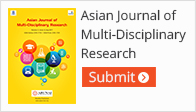ADSORPTION OF COPPER FROM WASTEWATER USING BIOPOLYMER
Dr.D. Saravanan1, P. N. Sudha2| Journal Title | : | Asian Journal of Applied Research |
|---|---|---|
| DOI | : | |
| Page No | : | 1-11 |
| Volume | : | 1 |
| Issue | : | 1 |
| Month/Year | : | 1/2015 |
Keywords
biosorption, copper, adsorption isotherm, composites, cross linking.
Abstract
Water is a basic human need, a finite life support system and a key to prosperity and sustenance of the life cycle. Unplanned industrialization, urbanization, rapid growth of population affects the aquatic environment. Large scale industrial, agricultural and environmental pollution generates volumes of wastewater which in turn affects the flora, the fauna, air, water and the soil. Among the industries, dyeing and printing industrial effluents discharge dyes loaded with heavy metals into aquatic ecosystems. The heavy metals render the water unsuitable for drinking and are also highly toxic to human beings. Removal of these metals is therefore essential. Adsorption studies have been used to remove Copper from aqueous solution was tested using chitin biopolymer. The sorption data obtained from batch method at optimized conditions have been subjected to Freundlich and Langmuir isotherm studies. The data were suitable for both Freundlich and Langmuir isotherm models indicating favorable and monolayer adsorption. FTIR study revealed that there is intermolecular molecular hydrogen bonding interaction between the two polymer components. XRD studies shows that the films to exhibit an amorphous character.


